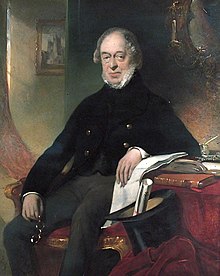Stephen Rumbold Lushington (6 May 1776 – 5 August 1868)[1] was an English Tory politician and an administrator in India. He was governor of Madras from 1827 to 1835.

Early life
editHe was born at Bottisham, Cambridgeshire, the son of the Rev. James Stephen Lushington of Rodmersham and his second wife, Mary Christian, daughter of the Rev. Humphrey Christian.[2] He was educated at Rugby School, and was in India from 1792. Initially he was a translator.
In England from 1807, he unsuccessfully contested the borough of Canterbury at the 1807 general election,[3] but in July that year he was elected at an uncontested by-election as a Member of Parliament (MP) for the borough of Rye in Sussex.[1][4] At the 1812 general election he was returned without a contest for Canterbury,[3] and held that seat until the 1830 general election. He was Secretary to the Treasury from 1814 to 1827.[1]
Lushington owned Norton Court in Norton, Kent,[5] where he knew Jane Austen,[6][7] and founded nearby schools.[8]
Governor of Madras
editIn 1827, Lushington was appointed governor of Madras in succession to Thomas Munro, 1st Baronet. But as Munro fell ill and died even before his tenure had ended, Henry Sullivan Graeme acted as the governor in interim till Lushington's arrival in Madras.
Lushington served as Governor of Madras from 1827 to 1832. The Madras Club was started in 1832 during Lushington's tenure as governor. In 1830, the Court of Directors of the East India Company sent a despatch to Madras urging the authorities to improve the quality of English education in the presidency.
Later life
editLushington unsuccessfully contested Canterbury again at the 1835 general election,[9] but the result was overturned on petition. He held the seat until he stood down in 1837.[1][9]
Family
editLushington was twice married.[1]
- Firstly, in 1797, he married Anne Elizabeth Harris (died 1856), da. of Gen. George Harris, 1st Baron Harris. They had six sons and two daughters.
- Secondly, in 1858, to Marianne Hearne, daughter of James Hearne of Great Portland Street. There was no issue.
Lushington's 1840 book The Life and Services of General Lord Harris, G.C.B. was a biography of his father-in-law by his first marriage.
References
edit- ^ a b c d e "Lushington, Stephen Rumbold (1776-1868), of Norton Court, nr. Faversham, Kent. History of Parliament Online". www.historyofparliamentonline.org.
- ^ Prior, Katherine. "Lushington, Stephen Rumbold (1776–1868)". Oxford Dictionary of National Biography (online ed.). Oxford University Press. doi:10.1093/ref:odnb/17215. (Subscription or UK public library membership required.)
- ^ a b Stooks Smith, Henry. (1973) [1844-1850]. Craig, F. W. S. (ed.). The Parliaments of England (2nd ed.). Chichester: Parliamentary Research Services. pp. 159–160. ISBN 0-900178-13-2.
- ^ Stooks Smith, pages 347–8
- ^ "Geograph: Norton Court (C) Penny Mayes". Geograph.org.uk. Retrieved 13 October 2017.
- ^ "Back to Clive Webb". Archived from the original on 24 July 2008. Retrieved 28 October 2007.
- ^ "Loading..." Chaptersofdublin.com. Archived from the original on 22 October 2007. Retrieved 13 October 2017.
{{cite web}}: CS1 maint: unfit URL (link) - ^ "1908 Directory NORTON". Freepages.genealogy.rootsweb.com. Retrieved 13 October 2017.
- ^ a b Craig, F. W. S. (1989) [1977]. British parliamentary election results 1832–1885 (2nd ed.). Chichester: Parliamentary Research Services. p. 78. ISBN 0-900178-26-4.